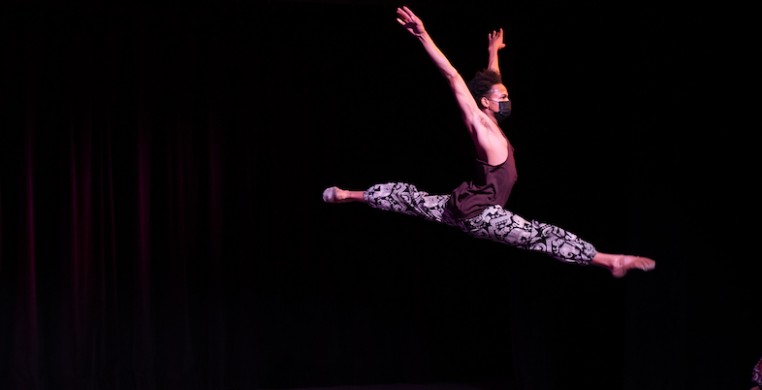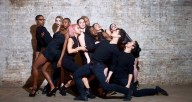UPDATE: The new seechicagodance.com will launch March 31st. Click here to learn more.
South Chicago Dance takes worthy risks working with words of Dr. King, Langston Hughes
Dancing set to spoken word, poetry and speeches is a good idea that does not always come across as good dancing. Several years ago, I saw tap dance set to a stand-up comedy routine. The end result was lackluster and clunky, because the choreographer and dancers were, in no way, comedians. Their argument was that if something like stand-up contains rhythm and meter, like music, then it can be danced to. That is true, but not when the choreographer cannot pin down what the rhythm is and where the meter begins. I have not seen tap dance set to spoken word in Chicago since, so bad was the taste left in our mouths.
But if there are more shows like the South Chicago Dance Theatre’s third annual performance celebrating Black History Month, then perhaps there are grounds to reconsider this juxtaposition of voice and dance, even among tap dancers. Streamed live last Friday in a modern, conventional, black curtained and phosphorescently lit theater—which would not have accommodated the 200+ viewers watching online—choreographer Kia Smith’s two new premieres, “I Too Sing America” and “Architect of a Dream,” nail down the flow and meter of the chosen works of language and speech, proving that these dancers and choreographer are, indeed, poets themselves.
Smith’s “Architect of a Dream,” set to Dr. Martin Luther King’s iconic “I Have A Dream” speech from the August 28, 1963 March on Washington, proves that anytime the use of this famous rhetoric comes off as overtly sentimental and overused is the fault of the artist. Smith uses lyricism to directly reflect the words of Dr. King into movement that, as performed by the company of dancers, is distinctly African with syncopated, flat-foot percussion and lowly-centered torsos undulating and oriented towards the earth. I was hit hard when the company of dancers repeatedly chanted the line “One-hundred years later,” serving as a painful reminder that the reference itself—pointing to the end of slavery in 1863—is, itself, now nearly 60 years old and is unfortunately still relevant.
Framing the dancers were occasional black and white videos from the ’63 March on Washington and of Dr. King speaking, which were poorly superimposed post-production and not only obscured the subjects in these videos, but distracted the viewer from the dancers. Maybe it is the pressure of creating “virtual art” and not just slapping flat dance on a screen, but the dancing is so excellent here that the overlay of video on live bodies felt unnecessary.
That is not to say that the video overlay didn’t work at all; I found images of Breonna Taylor and parts of the March on Washington footage during the segment titled “Let Freedom Ring” served as an effective backdrop when made to be features of the work and not a frame that competed with the dancers. “Architect of a Dream” builds to a climax as Sam Cooke’s “A Change Is Gonna Come” (as performed by Otis Redding) is expertly matched with Dr. King’s rhythm and timbre as a sea of dancers with flexed-feet and outstretched arms ebbed and flowed like agitated waves beating against a slowly relenting shoreside.
“I Too Sing America” is Smith's homage to the great American poet Langston Hughes and his poem of hope and triumph, “I Too.” Hughes, whose ability to communicate the complexities of humanity through a common, lay-person’s writing style is evident in Smith’s work here, as I saw a great amalgamation of ballet, contemporary and vernacular jazz dance put together in a way that complimented, not contrasted, with each other. Really, “I Too Sing America” is a love letter to American dance—i.e. Black American dance styles and their transformative influence on European styles—and Smith and Co. move through and combine each style so fluidly that it is more of an example of American dance as it has evolved rather than static moments used to describe a specific moment in time.
“I Too Sing America” differs from “Architect of a Dream” in that it is not only the voice of Hughes overlayed with music, but contains a healthy middle section of bebop jazz, particularly Jerome Kern’s “All the Things You Are,” as performed and arranged by Dizzy Gillespie. In this number, the bebop jazz aesthetic is well-maintained; each instrument gets its own voice interpreted through gorgeous solo spots from SCDT’s capable company of dancers. The combination of influences phased through each other so quickly that I could not tell if it was choreography or improvisation which, to me, is the mark of a good performance of either practice. Long, elegant battements languidly collapse into piles of jutting, abstract shapes, only to recover as a saucy upstage walk that uses slightly rolling heads and shoulders that seem to coyly say, “Oh, was that me?”
Smith blends different styles together in a way that seems colloquial and unpretentious. This company of dancers is so technically and emotionally capable—with stand-out performances by Morgan McDaniel and Kelly Anderson—that I believe it was instrumental in reflecting the conflicting sense of struggle and hope found in Dr. King’s rhetoric. Had the dancing not been so strong, I fear Smith would have risked losing the detailed nuance that connects her choreography to these great American works of language. I, for one, am glad she took the risk.


